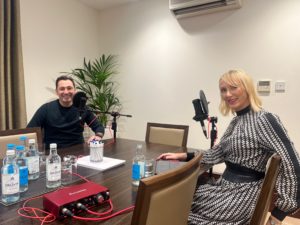
Esther: I’m here with Martin Mulligan from VUCA Treasury. VUCA is authorized by the FCA to provide advice to businesses on FX and interest rate exposures. Their insights and advice provide their clients with increased visibility over future cash flows, improved financial performance, and in this higher rate environment, often access more debt. So, on Valentine’s Day last year, we had a podcast to discuss the FX markets. Before the end of the month, the Johnson government had formally announced that Covid restrictions, including self-isolation, would finally cease, and Russia then invaded Ukraine. A lot has changed over the past 12 months!
Martin: Hi Esther, thanks for inviting me back, and I’m glad to see that after you allocated a certain amount of time on Valentine’s Day last year to spend with me, it hasn’t left you any permanent scarring. So many thanks for the repeat invitation. Look, it’s been a crazy 12 months. You know, it’s really hard to believe that within a couple of weeks of our podcast that Covid restrictions were finally released. In fact, I find it difficult to believe that it was as recent as 12 months ago. It seems like it was much, much longer. But it’s also difficult to believe that within two weeks that Putin sent his troops across the border into Ukraine and unleashed the biggest humanitarian crisis in Europe since World War 2 at the cost of so many lives that have been disrupted and displaced throughout Europe and lost, unfortunately, I read something during the week that, you know, it’s up to 300,000 people, soldiers, civilians who’ve been killed, it’s an absolute disaster on many, many levels.
It’s been a big issue. It hasn’t just been a regional issue. It’s been a big issue globally, given Russia and Ukraine’s position in terms of providing commodities to the world. So, oil and gas in Russia’s case, and grains like wheat and some oils like sunflower in Ukraine’s case. So, the ramifications have been global. When we last spoke 12 months ago, inflation was already becoming a bit of an issue. It had risen to 5% due to supply issues following the simultaneous reopening of economies after Covid. The Bank of England had just started to raise interest rates and was the first central bank to start doing that.
Interest rates were ten basis points. The base rate was at ten basis points in December. When we met in February, it was at fifty basis points, half percent. The pound was trading at a dollar 35 against the US dollar and one Euro 20. Flash forward 12 months and the base rate is at 4%, which is it highest level in 14 years. The pound is then at one twenty against the dollar, which is a fall of about 10%. And, at one point in September after ‘Trussonomics’, it looked like it was going to break below parity. While inflation looks like it peaked, it’s still above 10%. So, it’s been a massive year, lots of change, and even from the point of view of prime ministers, we’ve had three in the past 12 months. And Rishi Sunak is looking for a little bit uncomfortable at the moment as we speak with the Northern Ireland protocol rearing its head again. So, plenty of change I’m sure will be coming through in the next 12 months or so.
Esther: Yes, for sure. So, do you think that Covid and Ukraine will continue to be the primary factors affecting the markets over the next 12 months in the same way?
Martin: China is the second biggest economy in the world, and with China finally reopening after three years of lockdown and the path to resolution of the war in Ukraine, still very much unclear. Both factors still have the ability to be wild cards. That said, in the short term, they’re not as important for foreign exchange and interest rate markets. A range of commodity prices from oil and gas, to wheat are a fraction of the levels they’re trading at during the summer months. In Gas’s case, European gas prices are at a 18 month low, so they’re much lower now than they were on the eve of the Russian invasion. Over the medium to long term, both factors can still have a material impact on growth and inflation. There will be a boost of growth eventually from the rebuilding of Ukraine. I saw one estimate in the New York Times recently where the cost to rebuild the physical infrastructure alone could be anywhere between 150 and 750 billion.
We’re also seeing, both from Covid and from Ukraine a move towards nearshoring supply chains. Partly due to issues around Covid, but also because of those sorts of risks around security of both energy and food that we’ve seen, particularly with energy in Europe over the last 6 to 12 months. I think both factors, if they do provide a boost to growth, you could well see that inflation could find an equilibrium level, a much higher level than they would have otherwise, and that could influence both inflation and growth over the medium to long term.
The main economic data that markets are watching at the moment is inflation. And both this current level and shift in expectations around how quickly it can return to central banks like the Bank of England and the ECBs, 2% targets. Three year fixed rates started out 2023 at 4.3%, fell to 3.5% at the start of February, and are back up at 4.1% now. So, these larger reversals in rates, big moves down, big moves up, over such a short period of time reflect the lack of clarity there is around the path for both growth and inflation at the moment.
Esther: Sure. So as a business that specializes in managing interest rate risk, what have you noticed over the past year as rates have gone from close to zero right to 4%?
Martin: Well, for the most part, clients that we speak to don’t have a dedicated treasurer, so that internal subject matter expert who’s looking constantly at cash management and financial risks. So, what we found is that many SMEs and mid-cap firms were ill-prepared because they didn’t have a framework to manage interest rate risk. So, firms were reacting to events instead of getting ahead of them. This has meant that many firms weren’t able to respond quickly enough to the rapid changes in the interest rate environment. Anecdotally, we notice a spike in hits over our website following key events like the August monetary policy meeting. The Bank of England raised interest rates by a larger fifty basis points rather than a typical twenty-five basis points move. And we also saw a spike in activity at the end of September following the Kwarteng mini budget.
The Bank of England has already delivered five interest rates before the August meeting, so there’s plenty of opportunity for firms to make an informed decision around managing their interest rate risks if they had the framework in place. Unfortunately, in many cases they didn’t. And what we’ve also noticed is that the interest rate risk management is now a strategic concern. For over 10 years, the floating rates were low and stable. In the UK they ranged between ten basis points and 1% since 2009. So previously low and stable was the mantra, now it’s higher for longer from the central bank. So, the increased cost of borrowing from higher rates is impacting the amount of debt firms can service and the amount of debts that lenders are prepared to extend. So how firms fund themselves and allocate capital is now a real issue, especially in interest rate sensitive sectors like real estate or leverage debt markets.
We’ve also found that there’s been a very limited understanding of interest rate hedging on a number of transactions where we’ve been mandated to arrange the interest rate hedge. We found that many borrowers and debt advisors have had minimal understanding of many aspects of hedging interest rate risk. On occasion we’ve even seen that lenders weren’t familiar with the relevance or purpose of some components in the hedging clause of facility agreements that they’ve been issuing to their clients. Ultimately, it’s been a massive learning curve. So, anybody who joined the workforce after 2008 would not have considered managing interest rate risk as a priority. They wouldn’t have seen interest rate rises. So given that central banks have now tightened interest rates more aggressively than any other time in over 40 years, it’s been a steep learning curve for all parties. So as a business, we spend a lot of time educating clients on the finer aspects of managing interest rate risk so they can make those informed decisions.
We’ve also noticed that banks at the time 12 months ago, were happy to get any sort of an interest rate deal on their books. So, they were very accommodating. What we’ve seen over the last 12 months is that some banks are only happy to provide interest rate caps to their own clients. They may have raised the minimum deal size from below 10 million, certainly between 10 and 20 million to something maybe north of 50 million from many of their larger investment banks, and that the pricing has widened as well. So as demand has risen, the price has gone up. So, the price of buying a cap now in terms of the spread that the banks will charge is maybe two, three, x the level that it was at 12 months ago. So it’s been quite a few changes.
Esther: Sure. What kind of issues have high interest rates presented for clients? Have you found?
Martin: Well, this sharp rise in interest rates has affected companies in different ways. It’s an opportunity for clients who are cash rich and, it’s a risk for companies that need to borrow. For companies that need to borrow it’s really important how they allocate capital now that the era of free money is over. So, what I found quite interesting just before we set up the podcast today is that there’s been a couple of articles in the newspapers over the last week or so, which I think are really relevant. So, from a boring point of view, there’s an article which I’ve seen in the Times, but also in other news sources as well about Morrison’s the supermarket chain talking about how their interest rate expense, which is 375 million is over two times the cash flow they’ve got available for debt service and will remain so for the next couple of years, was a big issue for them.
We’re seeing debt serviceability obviously being an issue as I’ve just spoken about. What we’re also seeing is that there’s covenant breaches now. So, whether soft covenant breaches or hard covenant breaches so many companies are now having to put cash in to provide an equity cure when those breaches have arisen. What we’ve also noticed, which is quite interesting from borrowers, is that they’re now focused on the refinance risk. So not just the existing debt, but what happens after the debt expires. So, companies are beginning to look at that risk of where market rates are going be in 6, 12, 18 months when they need to refinance their loans. What we’re also seeing from a banking point of view is that on new transactions which mean broad to banks, there’s a much greater focus on debt serviceability than there has been in the past.
There’s much more focus on the interest rate cover covenants as well. Banks are stress testing affordability at 2% above the forward curve for interest rates. Decision making processes are much slower as well. So, if you’re trying to get a loan agreed with the bank, which might have taken, let’s say 12 weeks is now taken 16, 20 weeks. There’s been also much more tightening of credit sentiment as well. So, the types of projects that banks will lend against, it’s also much tighter. Not only in the UK but also in Europe as well. There’s a survey from the ECB late last year around credit and the ECB noticed that credit is much tighter in the Eurozone now than at any other time since the global financial crisis in 2007, 2008.
For cash positive companies there’s been a couple of articles in the paper over the last while about NatWest. They’ve just reported the biggest profits since 2008, and HSBC who’ve announced that their quarterly profits have doubled. And in both cases, the big reason why profitability has improved is because interest rates are higher, and they’ve been able to widen out their interest rate margin. So, what I’ve found is that even though the base rate is at 4% at the moment, many high street banks are still offering only 1% on easy access deposits. A very easy way to improve profitability is just to shop around and look to see what sort of deals are out there. For anybody who’s cash positive, when they’re making those decisions in terms of how they place their funds, there’s that constant trade off between security, making sure that the counterparty has good credit rating, liquidity, making sure that you can get access to your funds when you need them. So, there’s no point in locking away money for six months if you’re going to need it in three, even if the rate is better. And then finally the return what interest rate you’re getting on those deposits you place with your preferred bank.
Esther: Yes. Sure. That totally makes sense. So, what have you seen that clients are doing to manage this risk in the main?
Martin: Hedging. We’ve seen a massive increase in hedging activity. Particularly in the middle of last year. We’re seeing clients being more strategic. So previously interest rate risk was ignored. Now it’s been elevated to a strategic concern. We’re seeing many companies look to use interest rate hedging as a means to increase the leveraging transactions, as I’ve mentioned previously banks are beginning to assess affordability by stress testing interest rates by 2% above the forward curve. Stress testing is not required if there’s a hedge in place as the interest expense is known or certain. So borrowers are seeing a hedge as being a vehicle to increase debt capacity as well as its traditional purpose, which is to mitigate risk. As I mentioned, also we’ve also seen increased appetite to hedge to use hedging to control refinance risk.
And we’re also seeing companies begin to put in hedging policies. So increasingly clients want us to work with them to write hedging policies to guide their decision making. Hedging policy will force it’s firm to make a conscious decision around the amount of interest rate risk they’re prepared to tolerate and to take steps to address the situation when the risk is greater than the tolerance level stakeholders are prepared to accept. It’s also great comfort to staff, transacting hedges on behalf of the firm as it provides them with a board approved framework to operate within. So, in terms of a good hedging policy, some of the things that companies need to consider is how much to hedge, 50%, 75%, a hundred percent of the debt, for how long the terminal facility, shorter or maybe even longer. What type of products they can use? What counterpart they should be using to hedge with? Who can deal within the company? And finally, what will happen if there’s a breach of the hedging policy that needs to be escalated?
Esther: Sure. Okay. thank you, Martin, that’s super helpful. So finally, what tips do you have for borrowers at this point in time?
Martin: The first tip is just to take time to understand your risk. Model your cash flows under different scenarios, flexing both income and interest rates. So, you’ve got a good strong understanding of the conditions that would need to prevail to play strain on profitability or loan covenants. If you decide that a hedge is required, get proper advice if you don’t have the skillsets internally to make that informed decision. A hedge is a commitment that often extends for three or more years, and a wrong decision can affect performance for an extended period of time. An important one: don’t be afraid to negotiate on price. Like any product you buy, there may be some wiggle room in the initial price that a bank shows. At VUCA Treasury we have the same pricing models that banks use, so we know where the true price is and we recently saved a client over a hundred thousand pounds because they didn’t realize that the bank would look to profit from the hedge given that they were being charged an arrangement fee for loan as well as paying margin on the loan.
Even if you don’t have access to those pricing tools, it’s worth pushing back anyway to see whether there’s any flexibility there in pricing. It’s important to also consider the cost to enter a hedge, the running cost of the hedge, and the cost to exit the hedge when looking to put a hedge in place. Look at things in the round. With the interest rate curve now inverted, so that means that shorter term interest rates are higher than longer term interest rates. The temptation is to fix for longer and pick up that initial benefit from the lower longer fixed rate. For example, two-year fixed rate at the moment is 4.3%, but five year rate is 3.9. The pass may not be a good guide to the future, but interest rate cycles previously it has made more sense to avoid fixing when we’re towards the middle or the end of a tightening cycle because interest rates did come down and instead of being fixed at 3.9% products like a cap for example, will allow you to benefit from floating interest rates while still giving you that same type of protection.
As I’ve said, take time to put a policy in place. It provides that framework for a firm to manage risks and protect employees who are booking transactions. And finally, it’s not too late to hedge. We sometimes hear potential clients say that they feel they’ve missed the boat. This is understandable given the pace of change in rates over the last 12 months. But one thing that we have learned over this period is that you never know what is around the corner. Rates have been a lot higher than this in the past. If you go back to 2007, the base rate was at 5.75 instead of the 4% level it out the loan. If the most appropriate course of action is to control your interest costs, there’s still plenty of time to protect your business.
Esther: Okay, thank you Martin. That’s really helpful. Thank you so much for coming in. It’s good to see you again after a year, a year of change. If you’d like to speak to Martin direct, please contact him on his website or speak to your usual Goodman Jones partner who’ll be happy to introduce you. Thank you so much.
The information in this article was correct at the date it was first published.
However it is of a generic nature and cannot constitute advice. Specific advice should be sought before any action taken.
If you would like to discuss how this applies to you, we would be delighted to talk to you. Please make contact with the author on the details shown below.








